
Dalbergia is a large genus of small to medium-size trees, shrubs and lianas in the pea family, Fabaceae, subfamily Faboideae. It was recently assigned to the informal monophyletic Dalbergia clade : the Dalbergieae. The genus has a wide distribution, native to the tropical regions of Central and South America, Africa, Madagascar and southern Asia.
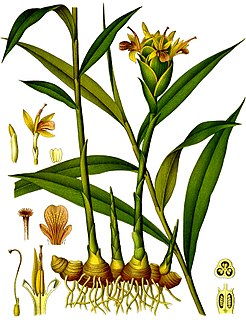
The genus Zingiber is native to Southeast Asia especially in Thailand, China, the Indian Subcontinent, and New Guinea. It contains the true gingers, plants grown the world over for their medicinal and culinary value. The most well known are Z. officinale and Z. mioga, two garden gingers.

Pogostemon is a large genus from the family Lamiaceae, first described as a genus in 1815. It is native to warmer parts of Asia, Africa, and Australia.

Litsea is a genus of evergreen or deciduous trees or shrubs belonging to the laurel family, Lauraceae. The genus includes a large number of accepted species in tropical and subtropical areas of North America and Asia.

Tetrastigma is a genus of plants in the grape family, Vitaceae. The plants are lianas that climb with tendrils and have palmately compound leaves. Plants are dioecious, with separate male and female plants; female flowers are characterized by their four-lobed stigmas. The species are found in subtropical and tropical regions of Asia, Malaysia, and Australia, where they grow in primary rainforest, gallery forest and monsoon forest and moister woodland. Species of this genus are notable as being the sole hosts of parasitic plants in the family Rafflesiaceae, one of which, Rafflesia arnoldii, produces the largest single flower in the world. Tetrastigma is the donor species for horizontal gene transfer to Sapria and Rafflesia due to multiple gene theft events.
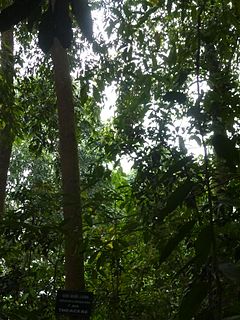
Adinandra is a genus of plant in the family Pentaphylacaceae. It contains the following species:

Alphonsea is a genus of plant in the family Annonaceae. As of April 2014 The Plant List recognises 38 accepted species:
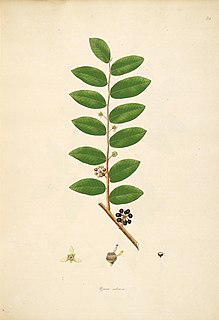
Polyalthia is a genus of flowering plants in the family Annonaceae. There are approximately 90 species distributed from Africa to Asia and the Pacific.

Blumea is a genus of flowering plants of the family Asteraceae.

Artabotrys is a genus of plants in the Annonaceae family. There are over 100 species in the Old World tropics, with 31 species in Africa. It is part of the custard apple family (Annonaceae). All species are small trees or shrubs with a tendency to climb. Leaves are simple and alternate, without hairs. Bisexual flowers are borne singly or in clusters opposite the leaves. The 6-petalled flowers are scented, and the plant bears fleshy fruits.
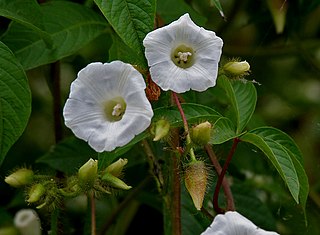
Merremia is a genus of flowering plants in the morning glory family, Convolvulaceae. Members of the genus are commonly known as woodroses.

Elsholtzia is a plant genus in the Lamiaceae. It is widespread across much of temperate and tropical Asia from Siberia south to China, Northeastern India, Indonesia, etc. The genus was named in honour of the Prussian naturalist Johann Sigismund Elsholtz.
- Elsholtzia amurensisProb. - Amur region of Russia
- Elsholtzia angustifolia(Loes.) Kitag. - Korea, Manchuria
- Elsholtzia argyiH.Lév. - southern China, Vietnam
- Elsholtzia beddomeiC.B.Clarke ex Hook.f. - Myanmar, Thailand
- Elsholtzia blanda(Benth.) Benth. - southern China, Himalayas, Indochina, Sumatra, Viet Nam
- Elsholtzia bodinieriVaniot - Guizhou, Yunnan
- Elsholtzia byeonsanensisM.Kim - South Korea
- Elsholtzia capituligeraC.Y.Wu - Tibet, Sichuan, Yunnan
- Elsholtzia cephalanthaHand.-Mazz. - Sichuan
- Elsholtzia ciliata(Thunb.) Hyl. - widespread across Siberia, Russian Far East, China, India, Himalayas, Japan, Korea, Indochina
- Elsholtzia communis(Collett & Hemsl.) Diels - Myanmar, Thailand, Vietnam
- Elsholtzia concinnaVautier - Nepal, Sikkim, Bhutan
- Elsholtzia cyprianii(Pavol.) C.Y.Wu & S.Chow - central + southern China
- Elsholtzia densaBenth. - India, Pakistan, Nepal, Bhutan, Afghanistan, Kyrgyzstan, Tajikistan, Tibet, Xingjiang, China, Mongolia
- Elsholtzia eriocalyxC.Y.Wu & S.C.Huang - southern China
- Elsholtzia eriostachya(Benth.) Benth. - China, Tibet, Himalayas
- Elsholtzia feddeiH.Lév - China, Tibet
- Elsholtzia flavaBenth. - China, Himalayas
- Elsholtzia fruticosa(D.Don) Rehder - China, Himalayas, Tibet, Myanmar
- Elsholtzia glabraC.Y.Wu & S.C.Huang - China
- Elsholtzia griffithiiHook.f - Myanmar, Assam
- Elsholtzia hallasanensisY.N.Lee - Jeju-do Island in Korea
- Elsholtzia heterophyllaDiels - Yunnan, Myanmar
- Elsholtzia hunanensisHand.-Mazz. - southern China
- Elsholtzia kachinensisPrain - southern China, Myanmar, Thailand
- Elsholtzia litangensisC.X.Pu & W.Y.Chen - Sichuan
- Elsholtzia luteolaDiels - Sichuan, Yunnan
- Elsholtzia minimaNakai - Jeju-do Island in Korea
- Elsholtzia myosurusDunn - Sichuan, Yunnan
- Elsholtzia nipponicaOhwi - Japan
- Elsholtzia ochroleucaDunn - Sichuan, Yunnan
- Elsholtzia oldhamiiHemsl. - Taiwan
- Elsholtzia pendulifloraW.W.Sm - Yunnan, Thailand, Vietnam
- Elsholtzia pilosa(Benth.) Benth. - China, Himalayas, Myanmar, Vietnam
- Elsholtzia pubescensBenth. - Java, Bali, Lombok, Timor, Sulawesi
- Elsholtzia pygmaeaW.W.Sm. - Yunnan
- Elsholtzia rugulosaHemsl - southern China, Myanmar, Thailand
- Elsholtzia serotinaKom - northern China, Japan, Korea, Primorye
- Elsholtzia soulieiH.Lév. - Sichuan, Yunnan
- Elsholtzia splendensNakai ex F.Maek. - China, Korea
- Elsholtzia stachyodes(Link) Raizada & H.O.Saxena - Indian Subcontinent, China, Myanmar
- Elsholtzia stauntoniiBenth. - northern China
- Elsholtzia strobilifera(Benth.) Benth. - China, Himalayas, Myanmar
- Elsholtzia winitianaCraib - Yunnan, Guangxi, Laos, Thailand, Vietnam
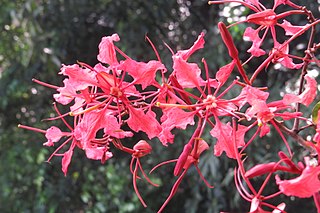
Phanera is a genus of flowering plants in the legume family, Fabaceae. It belongs to the subfamily Cercidoideae. This genus differs from Bauhinia in being vines or lianas, generally with tendrils and a lobed rather than spathaceous calyx, and from Schnella in having only three fertile stamens rather than ten, and being native to the Indomalayan realm and the Australasian realm rather than the Americas. The subsection Corymbosae was recently segregated into a new genus, Cheniella. It has been suggested that the genus Lasiobema should be reduced to a section within Phanera.

Globba is a genus of plants in the ginger family. It contains about 100 species, native to China, the Indian Subcontinent, Southeast Asia, New Guinea, the Bismarck Archipelago and Queensland.

Erycibe is a genus of plants in the family Convolvulaceae, found in the Andaman Islands, Sri Lanka, India including Assam, Bangladesh, Myanmar, east Himalaya, southern and southeastern China including Hainan and Taiwan, Southeast Asia, Malesia, Papuasia, Australia, and Japan including the Ryukyu Islands.















